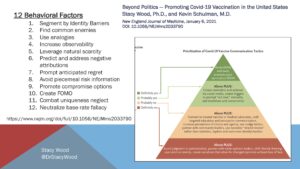Expert Panel Covers Critical Issues in COVID Vaccine Promotion and Distribution

The Supply Chain Resource Cooperative hosted two world leading experts, Professors Stacy Wood and Julie Swann, for a webinar on consumer marketing and vaccine distribution on Friday February 5, which was attended by over 160 attendees. The lessons learned during the event provided some important insights for government and healthcare providers alike, as well as anyone who is concerned about receiving the COVID vaccine this year. We are fortunate to have these industry thought leaders right here at NC State University. Two faculty members, Tim Kraft and Eda Kemahlioglu Ziya, organized the workshop which was held in lieu of an academic conference on supply chain sustainability that was planned for this year.
The first session was led by Professor Stacy Wood, Professor of Marketing, who is also the Editor in Chief of the Journal of Consumer Research, one of the premiere journals in the field of marketing. Professor Wood spoke at length about a recent article published in the New England Journal of Medicine, and which is based on work she did with Dr. Kevin Schulman, a physician at Stanford University. The work began around the area of “healthy behaviors,” (like stopping smoking or eating more healthy foods), which then pivoted into the area of COVID vaccines. This problem became apparent when recent research by Pugh Research which suggests that about 60% of people are interested in getting the vaccine, and 39% say probably not or definitely not. In order for the country to reach the critical 80% hurdle of “herd immunity,” the healthcare community will somehow need to get some of the people in the “probably not” and “definitely not” groups to change their mind. How to achieve this?
Dr. Wood began by drawing on concepts of marketing related to “the compromise effect,” which is the tendency of people to favor middle options, and to take this lens and apply it to public health. The compromise effect is much more influential when people are uncertain. For instance health insurance plans offer 3 options- good, better, best-and most people choose the “better” option. By applying the theory of the compromise effect, Drs. Wood and Schulman were able to define 12 key behavioral factors shown in the figure below, that could be relied on to gain greater vaccine compliance.

Many of the behavioral elements are combined into the strategies. For instance, one is to use analogies, not statistics to persuade people. Numeracy rates are often very low in general, and people don’t even understand the probabilities associated with winning the Lottery (1 in 1oo million!). For instance, one analogy is that the vaccine is like introducing a martial arts instructor into your body to train it how to fight off the virus. Another strategy is to have corporate leaders and community leaders get the vaccine, and to provide financial incentives to people who get both shots. Building pride and employee loyalty by getting the vaccine can be promoted. A great example was the Cherokee Nation, who recently announced that anyone in the community who could speak Cherokee would be prioritized for the vaccine, as this was needed to ensure continuity of the culture of the Cherokee Nation. Dr. Wood’s research is having a big impact, as she is speaking to the World Bank and federal healthcare agencies on her findings.
Dr. Julie Swann is the A. Doug Allison Distinguished Professor of the Fitts Department of Industrial and Systems Engineering, and has extensive experience working in humanitarian logistics. She was an advisor to the Obama Administration on the deployment of the H1N1 vaccine, and has grants from the CDC to focus on building simulation models to help determine optimal logistics planning for the COVID vaccination. Her discussion, “Informing an Efficient, Effective and Equitable Response to the COVID-19 pandemic involved sharing some of her insights on disease modeling, focusing on the prevention. The basic disease model is to classify everyone in a population into the categories of Susceptible, Exposed, Infectious, and Recovered. Variation between these states is a function of many variables, one of which is the rate of infectiousness – which for COVID is very high (2 to 3) vs. 1.3 for SARS and measles. This means that each individual can infect 3 other persons – and impacts the probabilities between states.
There are many different interventions that can be used to impact people’s behavior – including telecommuting, masking, and of course vaccines. Swann’s research looks at the impact of these interventions, the timing, and the impact on the spread of the disease. Here are some of the highlights from her studies to date:
- Increasing mask wearing can take infection levels of 75% in a population down to 15% – a 50% reduction.
- The quality of masks matters. Surgical masks, N95’s, and those with a tight weave can reduce infections by 10 to 18%
- The highest risk areas are in urban and suburban areas, with no mask wearing
- Vaccines can reduce the number of daily infections in a population, not by as much as you’d think, but it is still significant.
- Surveillance testing, especially in environments that are high risk like universities, can have a big impact on spread.
Swann also noted that for the states that have done well in vaccinations, like SD, MN, MA, VT, and AL, it is because they have had better infrastructure. But she also pointed to the fact that the lead times for administering the vaccine is longer than you think due to distribution lags in the process. However, we are in a race again the spread of mutations, and as we vaccinate more individuals, hopefully by late September and October the country and the world will be in a place where the spread is halted, and no more mutations will emerge.
We wish to thank both these presenters for their fantastic insights, and be sure to watch the whole video to learn more!


